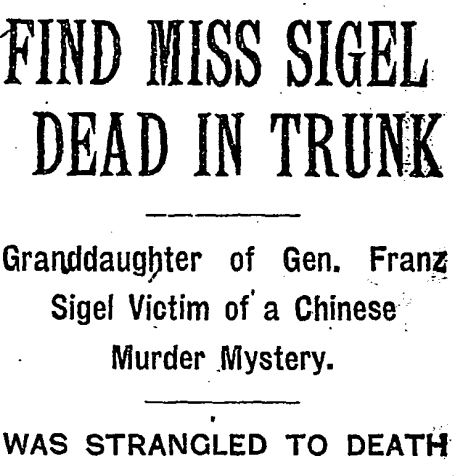How racism, a famous grandpa & Yellow Journalism created a Turn of the Century Whodunnit?
The late Victorians and Edwardians relished a good murder. Consider how our British cousins were fascinated by Jack the Ripper’s killings. The same was true on this side of the pond. When fame, notoriety and crime were rolled into one story, reported by sensational Yellow Journalists to boot, the public couldn’t get enough sordid details.
 But seldom was their fiendish appetite indulged as intensely as it was with one Big Apple homicide in the early 20th Century. Almost entirely forgotten today, it was a forerunner of the O.J. Simpson-Nicole Brown Simpson media circus that would follow 85 years later. And it carried ugly consequences for one group of people. With that introduction, let us return to the summer of 1909.
But seldom was their fiendish appetite indulged as intensely as it was with one Big Apple homicide in the early 20th Century. Almost entirely forgotten today, it was a forerunner of the O.J. Simpson-Nicole Brown Simpson media circus that would follow 85 years later. And it carried ugly consequences for one group of people. With that introduction, let us return to the summer of 1909.
If the telegram was meant to reassure her parents, it didn’t work.
“Will be home soon, or Sunday evening,” it said. “Don’t worry.” It carried the initials EJS.
But the parents did worry, because until then, they hadn’t seen or heard from 19 year-old Elsie J. Sigel for several days.
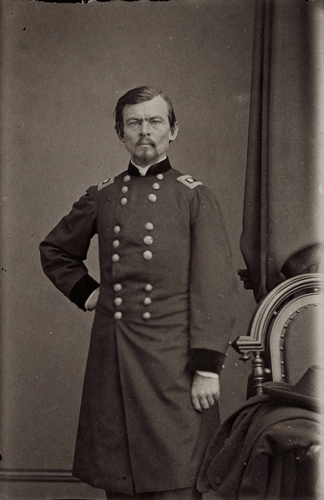 The Sigels were socially prominent and highly respected. Elsie’s grandfather Franz Sigel had been a famous Union general in the Civil War. A German immigrant, he was a so-so commander at best on the battlefield (where he was often more helpful to his Confederate opponents than to the Yankees). But he was a gifted self-promoter and was something of a pinup boy to pro-Union German-Americans who adored him. So despite his sketchy combat record, Lincoln made sure Sigel received one high-profile assignment after another (thus keeping his name in the news and enhancing his status as a military recruiter. A popular song of the day included this line in German dialect, “I goes to fight mit Sigel.”) After the war, Sigel held a variety of minor federal government posts until being summoned to his heavenly reward in 1902. When a public statue of Sigel was unveiled in 1907, an estimated 100,000 New Yorkers were on hand. And the city’s Franz Sigel Park still memorializes him.
The Sigels were socially prominent and highly respected. Elsie’s grandfather Franz Sigel had been a famous Union general in the Civil War. A German immigrant, he was a so-so commander at best on the battlefield (where he was often more helpful to his Confederate opponents than to the Yankees). But he was a gifted self-promoter and was something of a pinup boy to pro-Union German-Americans who adored him. So despite his sketchy combat record, Lincoln made sure Sigel received one high-profile assignment after another (thus keeping his name in the news and enhancing his status as a military recruiter. A popular song of the day included this line in German dialect, “I goes to fight mit Sigel.”) After the war, Sigel held a variety of minor federal government posts until being summoned to his heavenly reward in 1902. When a public statue of Sigel was unveiled in 1907, an estimated 100,000 New Yorkers were on hand. And the city’s Franz Sigel Park still memorializes him.
Sigel’s second son, Paul, was wealthy. Like many society women of that era, his wife Anne taught Sunday School for 17 years at genteel St. Andrew’s Church on Fifth Avenue. But this wasn’t your typical Sunday School class. This one was targeted to Chinese immigrants.
 Many Americans back then had a wariness born of lack of exposure to, and understanding of, the Far East. Christian missionaries were sent to evangelize the “heathen Chinese.” With Chinese immigration increasing during the late 1800s, some Americans feared the “Yellow Peril” of a United States overrun by Asians.
Many Americans back then had a wariness born of lack of exposure to, and understanding of, the Far East. Christian missionaries were sent to evangelize the “heathen Chinese.” With Chinese immigration increasing during the late 1800s, some Americans feared the “Yellow Peril” of a United States overrun by Asians.
Chinese Sunday School classes were in vogue at the time in many cities. Young Chinese men viewed them as an opportunity for improving their English, and for doing a little social and employment networking, too.
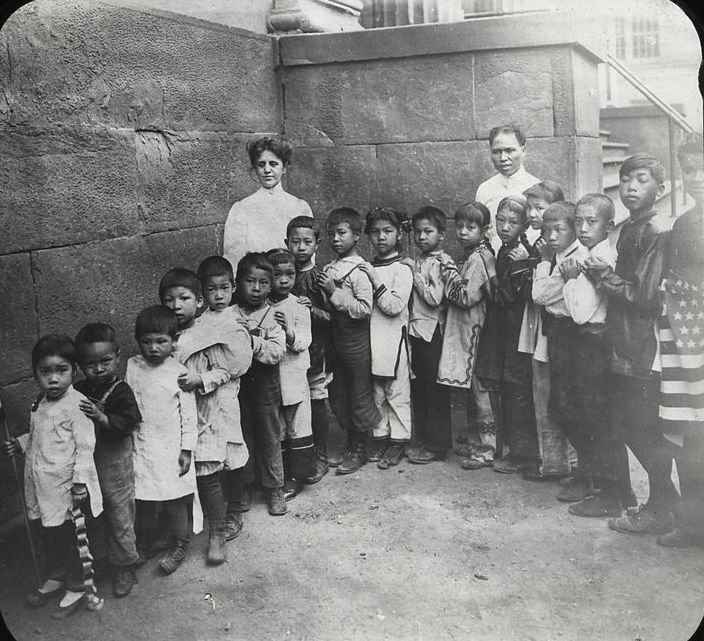 Against her husband’s wishes, Anne took daughter Elsie with her to those classes and to perform volunteer work at the grandly named Chinatown and Bowery Rescue Settlement and Recreation Room for Girls, a flop house designed to help get prostitutes off the street.
Against her husband’s wishes, Anne took daughter Elsie with her to those classes and to perform volunteer work at the grandly named Chinatown and Bowery Rescue Settlement and Recreation Room for Girls, a flop house designed to help get prostitutes off the street.
While she was proud of her daughter’s activities, Anne wouldn’t have been happy if she had known the real reason for her daughter’s interest.
For unbeknownst to anyone, Elsie was sexually attracted to Chinese men.
Needless to say, that was a huge No-No in 1909, especially for a famous general’s rich granddaughter. Had it become public knowledge, the scandal would have been enormous.
 When she was 18, Elsie met a handsome, dapper 30 year-old man whose surname was Ling. (News accounts at the time identified his first name as William, Willie and Leon. Author Mary Ting Yi Liu, who wrote the definitive account of the case, calls him Leon, so I’m going with that.)
When she was 18, Elsie met a handsome, dapper 30 year-old man whose surname was Ling. (News accounts at the time identified his first name as William, Willie and Leon. Author Mary Ting Yi Liu, who wrote the definitive account of the case, calls him Leon, so I’m going with that.)
Leon sat with Elsie and her mother during church services. He frequently visited them in their posh Bronx home, and took them on tours of Chinatown. Elsie eventually began sneaking off to see Leon, and things quickly turned physical.
Fast forward to June 1909, Elsie’s mysterious disappearance and her short telegram. Yet despite her reassuring words, she didn’t come home as promised.
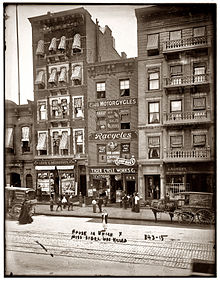 At the same time, a guy named Sun Leung ran a chop suey joint in Chinatown. He hadn’t seen his nephew Leon Ling for a few days. So he walked up to the apartment above the restaurant where Leon lived. He didn’t know which was more alarming … the silence that greeting his pounding on the locked door, or the foul smell coming from the other side of it.
At the same time, a guy named Sun Leung ran a chop suey joint in Chinatown. He hadn’t seen his nephew Leon Ling for a few days. So he walked up to the apartment above the restaurant where Leon lived. He didn’t know which was more alarming … the silence that greeting his pounding on the locked door, or the foul smell coming from the other side of it.
Fearing the worst, he sent for the police. They broke down the door, and found a trunk tied with awning rope. When they cut it, the lid flew open, pushed by what was inside. It was the severely decomposed body of a nearly naked young woman, bloated beyond recognition, a noose tied so firmly around her neck it cut the skin. One clue suggested the remains were those of Elsie Sigel: the pearly white, perfect teeth.
Her parents refused to claim the body, hoping it against hope it wasn’t their daughter.
Something else turned up in Leon’s room: more than 100 love letters from adoring women. And 35 of them had been written by Elsie. Consider this except: “Just think of the sacrifices I made for you – my family, my friends. For God’s sake, don’t forsake me.”
Then investigators made a bombshell discovery inside a dresser drawer; a bracelet with the initials EJS.
Paul Sigel denied it was his daughter’s. But Anne confirmed it, and collapsed under the strain of believing her missionary work had led to her daughter’s death. (She underwent early psychiatric treatment as a result.)
The murder was big news across the country. Police all over North America began rounding up any Asian man with a vague resemblance to Leon. But one suspect bore a closer look.
Chu Gain managed a popular Chinese restaurant that catered to upscale New Yorkers. He admitted having slept with Elsie, and to later receiving ominous, anonymous letters that said, “You know what will happen to you if you are seen with Elsie again. You’ll be killed and the girl too.”
Elsie, it seemed, was the center of a love triangle, playing one Chinese lover against another. One of her letters to Chu said, “I don’t want you to feel bad because he (Leon) was here last night. You know I love you and you only and always will.”
At the same time she was writing this to Leon: “Don’t think that I will ever give you up for anybody.”
Somebody, the evidence suggested, got jealous and decided to end things once and for all. But just who was that somebody?
 Police were looking for a man named Chong Sing, who lived in Leon’s building and disappeared at the same time he did. They eventually found him in upstate New York. After lengthy questioning, he told detectives he had spied on Leon through the transom above the apartment door, watching as his friend had ripped off Elsie’s clothing and strangled her. He said he played no role in the killing, but had helped Leon stuff the corpse into the trunk. When the lid wouldn’t close, they had tied it shut with rope.
Police were looking for a man named Chong Sing, who lived in Leon’s building and disappeared at the same time he did. They eventually found him in upstate New York. After lengthy questioning, he told detectives he had spied on Leon through the transom above the apartment door, watching as his friend had ripped off Elsie’s clothing and strangled her. He said he played no role in the killing, but had helped Leon stuff the corpse into the trunk. When the lid wouldn’t close, they had tied it shut with rope.
That, it seemed, explained everything … until Sing’s story hit a huge snag. Back at Leon’s apartment, detectives discovered there was no transom above the door. He changed his testimony so many times, police finally determined he was a worthless liar.
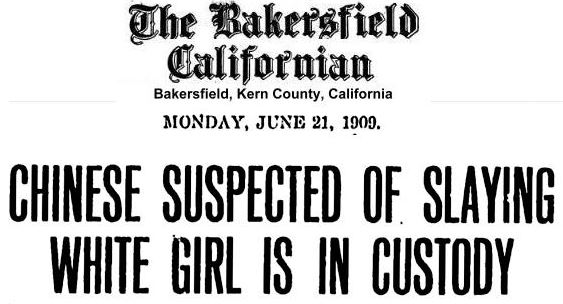 Conspiracy theories abounded. Leon had taken Elsie to Washington, where they were both murdered. Leon had fled to China. Leon had hustled Elsie off to spend the rest of her days as a human trafficking victim working as a prostitute in some Asian brothel. And the most far-fetched of all: the couple had used Elsie’s family money to pay for having another woman killed and stuffed into the trunk, with the pair then fleeing to China where they lived happily ever after.
Conspiracy theories abounded. Leon had taken Elsie to Washington, where they were both murdered. Leon had fled to China. Leon had hustled Elsie off to spend the rest of her days as a human trafficking victim working as a prostitute in some Asian brothel. And the most far-fetched of all: the couple had used Elsie’s family money to pay for having another woman killed and stuffed into the trunk, with the pair then fleeing to China where they lived happily ever after.
There was no CSI: New York in those days, and the case was never settled. No suspect was ever charged with the killing. It remains a murder without a murderer.
There was one sad consequence to this very sad story. For decades, Elsie’s torrid death was retold around the country as confirmation by those who believed the stereotype that Chinese men were opium fiends seeking any opportunity to rape white women. “That,” parents whispered to their daughters, “is what happens to young women who don’t behave properly.”
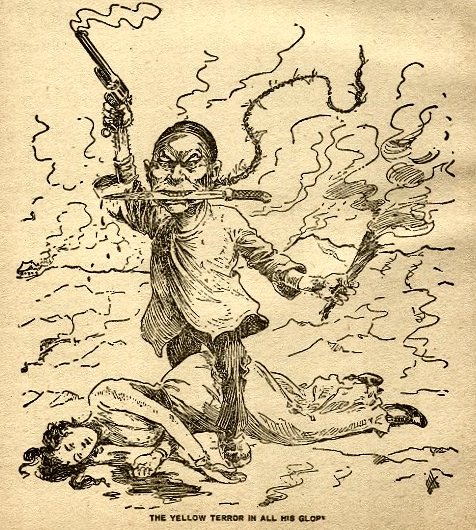 In other words: Elsie Sigel got what she deserved.
In other words: Elsie Sigel got what she deserved.
Strange to think that so much bigotry was the end the result of a mother practicing a religious faith that is based on the simple principle, “Love your neighbor.”
Did you find this enjoyable or helpful? Please continue to join me each week, and I invite you to read Tell it Like Tupper and share your review!
Curious about Tell It Like Tupper? Here’s a chance to see for yourself. Take a sneak peek at a couple chapters in this free downloadable excerpt.


